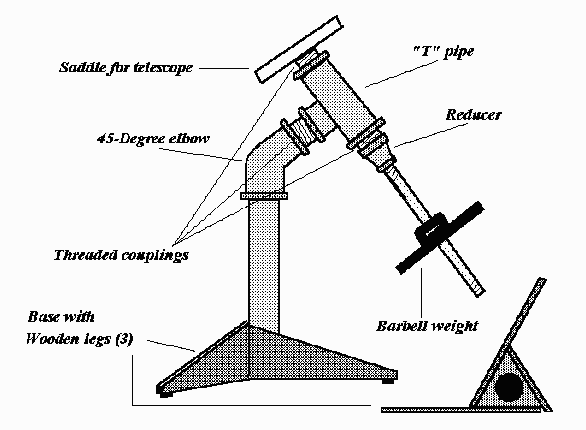Build Your Own Equatorial Mounting?
Jack Kramer
In the so-called "good old days" if you built your own telescope, you generally made an equatorial mount to go with it. Today the Dobsonian mounting prevails. The Dob is simpler to build...that's one reason why it's so popular. The equatorial is more complicated, but still not out of the question even for those with just basic tools. A book on homemade telescopes is highly recommended, but here are some suggestions on building a very basic plumbing pipe equatorial mounting.
Plumbing pipes have traditionally been a material used by amateur telescope makers to build the very simplest mountings. Here the bearing is one pipe that is screwed into another, just to the point where it's free to turn on the threads of the mating pipe. Since the normal rotation of the telescope as you follow objects in the sky subtends a very small arc, the pipes never screw together so that they tighten up, nor should they unscrew. Such mountings can be made to turn very smoothly by rubbing an emery polishing compound into the threads, then threading the pipes together and working them back and forth. After awhile, thoroughly clean off the emery and lightly grease the threads. One enhancement is to drill and tap holes in the pipes to add setscrews on both axes which act as adjustable brakes (or clutches) to tighten the rotation when needed. On equatorial mountings, as well as on Dobsonians, many people are surprised to find that making the bearings so they turn very freely actually creates more problems; there has to be a certain amount of friction, otherwise the telescope won't stay where you point it. To aim the polar axis toward the North Celestial Pole, a 45o elbow pipe will work nicely. Of course, that won't be your true latitude, but for visual observing it's often close enough. More exact alignment can be obtained by placing a shim under one leg of the mount to tip the polar axle more toward the pole.
A more sophisticated version of the GEM might use a set of self-aligning ball bearings mounted in pillow blocks in place of the turn-on-threads pipe mount.
The counterweight can be a barbell weight obtainable at most large sporting goods stores. Use a declination shaft extension pipe with an outside diameter that about matches the hole in the weight. A collar with setscrew will hold the weight in place on the shaft. The base can be a pedestal made from another piece of pipe or wood (such as a 4x4), or you may choose to make a tripod. The only problem with a tripod is that if the legs are spread too far apart, they'll obstruct the motion of the telescope when using it to look at an object near the zenith. A floor flange may be used to connect the pedestal to the base and also to connect the declination axle to the saddle for the telescope. You can always tell who's an old telescope hacker -- he shops for his mounting in the hardware store plumbing section!

![]()





